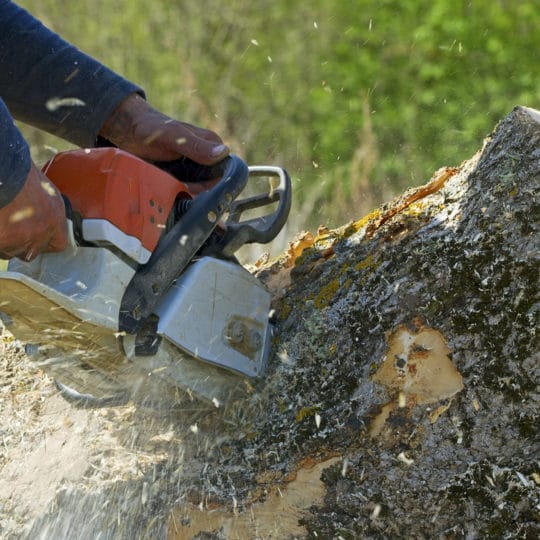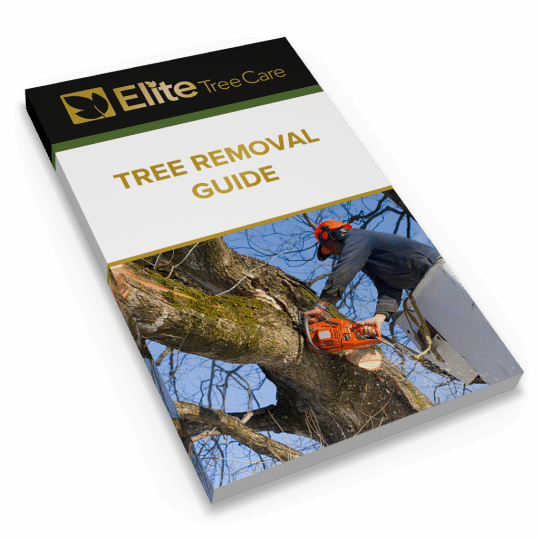DIY Tree Removal
And When to Call a Pro
Posted
March 24, 2022

When there’s a tree in your yard that’s beyond pruning or repair, it’s time to take it down. You may be wondering, can I do this myself? That all depends on the situation and condition of the tree. Follow this DIY tree removal guide to help decide if this project is safe enough for you or better left to a pro.
DIY Tree Removal Guide
Trees are large, beautiful plants that have many benefits to your yard and nature in general. However, sometimes the health of a tree dramatically declines and it becomes more of a hazard. In these cases, tree removal may be the best option.
When it comes time to remove a tree, there are certain aspects to think about if you’re considering taking on the job yourself. These are the top three:
- Size. A small, short tree is the easiest to remove yourself. If the tree towers over you and you can’t prune it without getting on a ladder, call a pro.
- Location. A tree that’s clear of any surrounding objects or obstacles is the safest to move. You may decide to relocate a young tree after realizing it’s not thriving in the original spot. If the tree is close to any structures or utility lines, call a pro.
- Condition. You can try to move a tree that’s stable and relatively healthy if necessary, either for remodeling or new construction purposes. If it’s dead, diseased, and unstable, call a pro.
No matter if you’re tackling the project or enlisting a pro, you still need to keep safety and process in mind. Taking on the job yourself requires extensive knowledge on how to properly cut down the tree safely and effectively. It all starts with research, the right equipment, and following the proper technique.
Tree Removal Research
Before you even cut down the tree, you need to determine why this is the best decision and plan out the steps before, during, and after tree removal. Ask yourself the following questions:
- Why are you removing the tree? Are you remodeling? Clearing a space for new construction? Is your tree not thriving in its current location?
- Are you ready to do it yourself? Do you have all the equipment necessary? Are you familiar with the process? What happens if something goes wrong?
- What comes next? Will you be moving it to a new location? Is that spot clear of obstacles?
After answering these questions, examine your tree and its surroundings. Prepare yourself and your tree for removal.
- Listen to your tree. Knock against the trunk with an ax. If it sounds hollow, it may be dying and not safe for you to cut down. If it sounds solid, it could be more difficult to cut. Do this at different points and heights and try to find a spot that will make the cutting easier.
- Map out its journey. If your tree is leaning a certain way, plan for a drop zone in that direction. This area should be level so there’s less of a chance it will roll down an incline.
- Is there dead or broken branches? You’ll want to get rid of these first before taking the whole tree down.
- Is there a clear area where it can safely fall? If not, clear a path. This may even require you pruning another tree with branches in the way.
- Do you have an escape route? If the tree doesn’t fall in the direction you’ve planned, you want to make sure you can get out of the way as quickly as possible.
- What are you going to do with the trunk and branches? Once the tree is on the ground, you’ll want to get it out of your yard, unless you don’t care about the grass underneath it. Will you mulch the branches? Chop the trunk for firewood? Use large logs for furniture? The choice is yours.
Tree Removal Equipment
If you’ve decided to remove a tree yourself, make sure you have all the equipment necessary before you start the job. Here are some of the basics.
- Protective gear. Safety first! Reduce the risk of injury during this process by outfitting yourself with proper arm and leg coverings, a hard hat, steel toe boots, earplugs, heavy-duty gloves, and goggles.
- First Aid kit. This is standard for any DIY project.
- Chainsaw. It’s the most efficient tool for taking a tree down and chopping the trunk and branches. Inspect it first to make sure the chain is sharp, it has enough fuel if needed, and it’s in proper working order.
- Ax. Also useful for making cuts and cleaning up.
- Rope. Helpful when leading branches or dragging them away.
DIY Tree Removal Process
To help make this process safe and efficient, follow these steps for removing a smaller tree that you plan on replanting:
- Water first. Drench the soil at least the day before you plan to remove the tree so that it’s easier to dig.
- Measure. Determine the diameter of your tree trunk, and for every inch, plan to dig six inches deep to reach the entire root system. Using that depth, dig around the tree’s roots, which likely extend to the outer edge of the tree’s canopy.
- Remove. Using leverage, wiggle the root ball out. Transplanting the tree will be more successful if the roots are intact. If you don’t plan on replanting, you can simply cut it up with a chainsaw, but make sure all the roots are removed from the ground.
If you’re taking down a larger tree without replanting:
- First cut. Make a horizontal cut no higher than your hip and less than one-third of the way into the trunk. The tree will fall perpendicularly to this cut.
- Wedge cut. When you’re done, this cut should look like a slice of fruit. It can be at the top or bottom of the horizontal cut.
- Back cut. Mark it at least an inch above the horizontal cut and make it as thick as possible. As you cut, you may want to use a wedge to help prevent the tree from settling onto the chainsaw.
- Get ready. As you’re finishing your back cut, the tree may begin to fall. If not, keep adding more wedges as necessary. Be ready to get out of the way.
- Timber! When the tree is on its way down, use your pre-determined escape route without turning your back on the tree.
Once the tree falls, it’s time to clean up. Removing the trunk, branches, and stump from your yard could be even more time-consuming than removing the tree itself. Consider the size of the tree and your options for using the wood or getting it out of your yard.
Want to Reconsider?
If this DIY tree removal guide makes it seem like this job is better left for pros, there’s no shame in getting help. This isn’t an easy process, and even a pro is putting themselves at risk during this unpredictable process. When you weigh all the options, costs, and what could go wrong, you may find removing a tree yourself is not worth the risk. When you’re ready to consider an insured specialist for the job, contact Elite Tree Care for an estimate.

Download Your FREE Tree Removal Guide
Even dedicated DIYers should think twice before taking on the task of tree removal. Our guide will help you decide whether to hire a tree service and how to get the most value for your money.